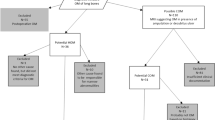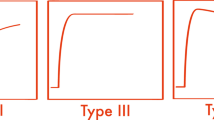Abstract
Objective
To find and evaluate characteristic magnetic resonance imaging (MRI) patterns for the differentiation between Ewing sarcoma and osteomyelitis.
Materials and methods
We identified 28 consecutive patients referred to our department for MRI (1.5 T) of an unclear bone lesion with clinical symptoms suggestive of Ewing sarcoma or osteomyelitis. MRI scans were re-evaluated by two experienced radiologists, typical MR imaging features were documented and a diagnostic decision between Ewing sarcoma and osteomyelitis was made. Statistical significance of the association between MRI features and the biopsy-based diagnosis was assessed using Fisher’s exact test.
Results
The most clear-cut pattern for determining the correct diagnosis was the presence of a sharp and defined margin of the bone lesion, which was found in all patients with Ewing sarcoma, but in none of the patients with osteomyelitis (P < 0.0001). Contrast enhancing soft tissue was present in all cases with Ewing sarcoma and absent in 4 patients with osteomyelitis (P = 0.0103). Cortical destruction was found in all patients with Ewing sarcoma, 4 patients with osteomyelitis did not present any cortical reaction (P = 0.0103). Cystic or necrotic areas were identified in 13 patients with Ewing sarcoma and in 1 patient with osteomyelitis (P = 0.004). Interobserver reliability was very good (kappa = 1) in Ewing sarcoma and moderate (kappa = 0.6) in patients with osteomyelitis.
Conclusions
A sharp and defined margin, optimally visualized on T1-weighted images in comparison to short tau inversion recovery (STIR) images, is the most significant feature of Ewing sarcoma in differentiating from osteomyelitis.




Similar content being viewed by others
References
Eggli KD, Quiogue T, Moser Jr RP. Ewing’s sarcoma. Radiol Clin North Am. 1993;31(2):325–37.
Grier HE. The Ewing family of tumors. Ewing’s sarcoma and primitive neuroectodermal tumors. Pediatr Clin North Am. 1997;44(4):991–1004.
Dominkus M, Kainberger F, Lang S, Kotz R. Primary malignant bone tumors. Clinical aspects and therapy. Vienna Bone Tumor Registry. Radiologe. 1998;38(6):82.
Dahlin DC, Coventry MB, Scanlon PW. Ewing’s sarcoma. A critical analysis of 165 cases. J Bone Joint Surg Am. 1961;43-A:185–92.
Wilkins RM, Pritchard DJ, Burgert Jr EO, Unni KK. Ewing’s sarcoma of bone. Experience with 140 patients. Cancer. 1986;58(11):2551–5.
Bernstein M, Kovar H, Paulussen M, Randall RL, Schuck A, Teot LA, et al. Ewing’s sarcoma family of tumors: current management. Oncologist. 2006;11(5):503–19. doi:10.1634/theoncologist.11-5-503.
Henk CB, Grampp S, Wiesbauer P, Zoubek A, Kainberger F, Breitenseher M, et al. Ewing sarcoma. Diagnostic imaging. Radiologe. 1998;38(6):509–22.
Durbin M, Randall RL, James M, Sudilovsky D, Zoger S. Ewing’s sarcoma masquerading as osteomyelitis. Clin Orthop Relat Res. 1998;357:176–85.
Grier HE, Krailo MD, Tarbell NJ, Link MP, Fryer CJ, Pritchard DJ, et al. Addition of ifosfamide and etoposide to standard chemotherapy for Ewing’s sarcoma and primitive neuroectodermal tumor of bone. N Engl J Med. 2003;348(8):694–701. doi:10.1056/NEJMoa020890.
Miser JS, Krailo MD, Tarbell NJ, Link MP, Fryer CJ, Pritchard DJ, et al. Treatment of metastatic Ewing’s sarcoma or primitive neuroectodermal tumor of bone: evaluation of combination ifosfamide and etoposide–a Children’s Cancer Group and Pediatric Oncology Group study. J Clin Oncol. 2004;22(14):2873–6. doi:10.1200/JCO.2004.01.041.
Mar WA, Taljanovic MS, Bagatell R, Graham AR, Speer DP, Hunter TB, et al. Update on imaging and treatment of Ewing sarcoma family tumors: what the radiologist needs to know. J Comput Assist Tomogr. 2008;32(1):108–18. doi:10.1097/RCT.0b013e31805c030f.
Erdman WA, Tamburro F, Jayson HT, Weatherall PT, Ferry KB, Peshock RM. Osteomyelitis: characteristics and pitfalls of diagnosis with MR imaging. Radiology. 1991;180(2):533–9.
McGuinness B, Wilson N, Doyle AJ. The “penumbra sign” on T1-weighted MRI for differentiating musculoskeletal infection from tumour. Skeletal Radiol. 2007;36(5):417–21. doi:10.1007/s00256-006-0267-1.
Fleiss JL. Measuring nominal scale agreement among many raters. Psychol Bull. 1971;76(5):378–82. doi:10.1037/h0031619.
Boyko OB, Cory DA, Cohen MD, Provisor A, Mirkin D, DeRosa GP. MR imaging of osteogenic and Ewing’s sarcoma. AJR Am J Roentgenol. 1987;148(2):317–22.
Hoffer FA. Primary skeletal neoplasms: osteosarcoma and Ewing sarcoma. Top Magn Reson Imaging. 2002;13(4):231–9.
Hoffer FA, Nikanorov AY, Reddick WE, Bodner SM, Xiong X, Jones-Wallace D, et al. Accuracy of MR imaging for detecting epiphyseal extension of osteosarcoma. Pediatr Radiol. 2000;30(5):289–98.
Weber KL, Sim FH. Ewing’s sarcoma: presentation and management. J Orthop Sci. 2001;6(4):366–71. doi:10.1007/s0077610060366.
Mellado Santos JM. Diagnostic imaging of pediatric hematogenous osteomyelitis: lessons learned from a multi-modality approach. Eur Radiol. 2006;16(9):2109–19. doi:10.1007/s00330-006-0187-4.
MacVicar AD, Olliff JF, Pringle J, Pinkerton CR, Husband JE. Ewing sarcoma: MR imaging of chemotherapy-induced changes with histologic correlation. Radiology. 1992;184(3):859–64.
Davies AM, Grimer R. The penumbra sign in subacute osteomyelitis. Eur Radiol. 2005;15(6):1268–70. doi:10.1007/s00330-004-2435-9.
Argyropoulou PI, Verettas DA, Prassopoulos P. “Penumbra sign” on magnetic resonance imaging. J Trauma. 2006;60(2):458. doi:10.1097/01.ta.0000202469.18359.1c. author reply 459.
Miller TT. Bone tumors and tumorlike conditions: analysis with conventional radiography. Radiology. 2008;246(3):662–74. doi:10.1148/radiol.2463061038.
Jerome JT, Sankaran B, Varghese M, Thomas S, Thirumagal SK. Rare presentation of Ewing’s sarcoma: a case report and literature review. J Pediatr Orthop B. 2008;17(5):261–4. doi:10.1097/BPB.0b013e3283069261.
Santiago Restrepo C, Gimenez CR, McCarthy K. Imaging of osteomyelitis and musculoskeletal soft tissue infections: current concepts. Rheum Dis Clin North Am. 2003;29(1):89–109.
Baraga JJ, Amrami KK, Swee RG, Wold L, Unni KK. Radiographic features of Ewing’s sarcoma of the bones of the hands and feet. Skeletal Radiol. 2001;30(3):121–6.
Meyers SP. MRI of bone and soft tissue tumors and tumorlike lesions: differential diagnosis and atlas. New York: Thieme; 2008.
Van der Woude HJ, Bloem JL, Hogendoorn PC. Preoperative evaluation and monitoring chemotherapy in patients with high-grade osteogenic and Ewing’s sarcoma: review of current imaging modalities. Skeletal Radiol. 1998;27(2):57–71.
Neubauer H, Evangelista L, Morbach H, Girschick H, Prelog M, Kostler H, et al. Diffusion-weighted MRI of bone marrow oedema, soft tissue oedema and synovitis in paediatric patients: feasibility and initial experience. Pediatr Rheumatol Online J. 2012;10(1):20. doi:10.1186/1546-0096-10-20.
Costa FM, Ferreira EC, Vianna EM. Diffusion-weighted magnetic resonance imaging for the evaluation of musculoskeletal tumors. Magn Reson Imaging Clin N Am. 2011;19(1):159–80. doi:10.1016/j.mric.2010.10.007.
Balliu E, Vilanova JC, Pelaez I, Puig J, Remollo S, Barcelo C, et al. Diagnostic value of apparent diffusion coefficients to differentiate benign from malignant vertebral bone marrow lesions. Eur J Radiol. 2009;69(3):560–6. doi:10.1016/j.ejrad.2007.11.037.
Conflict of interest
The authors declare that they have no conflict of interest.
Author information
Authors and Affiliations
Corresponding author
Rights and permissions
About this article
Cite this article
Henninger, B., Glodny, B., Rudisch, A. et al. Ewing sarcoma versus osteomyelitis: differential diagnosis with magnetic resonance imaging. Skeletal Radiol 42, 1097–1104 (2013). https://doi.org/10.1007/s00256-013-1632-5
Received:
Revised:
Accepted:
Published:
Issue Date:
DOI: https://doi.org/10.1007/s00256-013-1632-5




